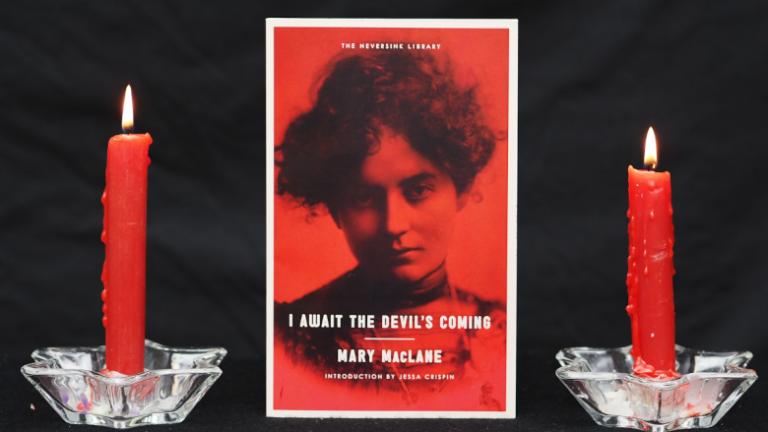This post was inspired by two books: one fiction, one non-fiction. The first is about a 19 year old woman who – in 1901, in Montana – wrote about her love for her “anemone lady” and her longing for the Devil. If you guessed that was the fiction, you made a reasonable guess. And a wrong one.
Our first book is I Await The Devil’s Coming by Mary MacLane. Her original title was too much for 1901 – it was published as The Story of Mary MacLane. It’s the diary (though she rejected that term, calling it instead a “Portrayal”) of a young woman who was frustrated by the limitations of living in a small Western town, and by the limitations of being a woman in a male-dominated era.
The book is out of copyright and is available for free on Project Gutenberg. The physical book is in print and available for purchase from the usual outlets. I encourage you to read at least a few pages of it. Her writing is quite good. I’m a man born 80 years after her, living 120 years after her book was published, but what she has to say is relatable to me, and I imagine to many of us who are dissatisfied with a world that panders to mundane preferences and prejudices and leaves us out in the cold.
Here’s the opening entry:
I of womankind and of nineteen years, will now begin to set down as full and frank a Portrayal as I am able of myself, Mary MacLane, for whom the world contains not a parallel.
I am convinced of this, for I am odd.
I am distinctly original innately and in development.
I have in me a quite unusual intensity of life.
I can feel.
I have a marvelous capacity for misery and for happiness.
I am broad-minded.
I am a genius.
I am a philosopher of my own good peripatetic school.
I care neither for right nor for wrong—my conscience is nil.
My brain is a conglomeration of aggressive versatility.
I have reached a truly wonderful state of miserable morbid unhappiness.
I know myself, oh, very well.
I have attained an egotism that is rare indeed.
I have gone into the deep shadows.
All this constitutes oddity. I find, therefore, that I am quite, quite odd.
And an excerpt from the second entry:
I wish to acquire that beautiful, benign, gentle, satisfying thing—Fame. I want it—oh, I want it! I wish to leave all my obscurity, my misery—my weary unhappiness—behind me forever.
I am deadly, deadly tired of my unhappiness.
I wish this Portrayal to be published and launched into that deep salt sea—the world. There are some there surely who will understand it and me.
Can I be that thing which I am—can I be possessed of a peculiar rare genius, and yet drag out my life in obscurity in this uncouth, warped, Montana town?
It must be impossible! If I thought the world contained nothing more than that for me—oh, what should I do? Would I make an end of my dreary little life now? I fear I would. I am a philosopher—and a coward. And it were infinitely better to die now in the high-beating pulses of youth than to drag on, year after year, year after year, and find oneself at last a stagnant old woman, spiritless, hopeless, with a declining body, a declining mind,—and nothing to look back upon except the visions of things that might have been—and the weariness.
I see the picture. I see it plainly. Oh, kind Devil, deliver me from it!
Her “Portrayal” was published the next year, in 1902. It sold over 100,000 copies and brought Mary MacLane the fame – and the exit from Montana – she so desired. As you might imagine, it was particularly popular with young women.
Her second book My Friend Annabel Lee (inspired by the Edgar Allan Poe poem “Annabel Lee”) was published the following year. Sales were good, but nowhere near as good as her first book. Her third and final book I, Mary MacLane: A Diary of Human Days was published in 1917, also with lower sales. The Wikipedia page on Mary MacLane suggests that it was “overshadowed by America’s recent entry into World War I” and that’s at least partially true. But in her introduction to the 2013 edition of I Await the Devil’s Coming, book critic Jessa Crispin said that what was new and shocking in 1902 was simply more commonplace by 1917 – the world caught up to Mary MacLane.
Mary MacLane died alone in her Chicago apartment in 1929. She was 48.
Plain Bad Heroines
The second book that inspired this post is Plain Bad Heroines, a 2020 novel by Emily M. Danforth.
In 1902, two students at a private girls’ school in New England find The Story of Mary MacLane and fall in love with it – and with each other. But then they’re mysteriously killed by a swarm of yellow jackets, which leads to more deaths and the eventual closure of the school. In the present, a young writer researches their story and writes a best selling book about it, which is turned into a movie – a movie whose production is haunted.
The title Plain Bad Heroines comes from Mary MacLane. In her Portrayal she complained about unrelatable characters in “girl-books” and then said “I wish some one would write a book about a plain, bad heroine so that I might feel in real sympathy with her.”
I’m not going to review Plain Bad Heroines. If you want a full review, Goodreads has 5000 of them. I will say that while the ending seemed rather rushed (which is odd in a book that runs over 600 pages), the story had me so engrossed I lost all track of time while I was reading it. If I do a Top Novels I Read This Year feature again in 2024, it has a very good chance of making the list.
What’s important here is that Emily Danforth was inspired by Mary MacLane and so she included Mary and her book in her own novel. And because of that, I learned about a fascinating woman and decided to write about her.
And now you know about Mary MacLane and I Await The Devil’s Coming.
Good writing enriches us all.
The Devil in Montana
In the United States, the further west you go, the less religious people are.
It’s always been this way. New England was settled by Puritans and later by Catholics. The South has always been solidly Protestant and remains so to this day. But the West was too busy and too isolated to get very deep into organized religion. There are exceptions – most notably Mormon Utah – but this is generally true. And at the same time, the whole country was – and still is, to a large extent – culturally Christian. It is odd to hear someone speak kindly of the Devil.
Mary MacLane grew up knowing the Devil and his stories, but she did not grow up to fear him. She wrote:
I am ready and waiting to give all that I have to the Devil in exchange for Happiness. I have been tortured so long with the dull, dull misery of Nothingness—all my nineteen years. I want to be happy—oh, I want to be happy!
The Devil has not yet come. But I know that he usually comes, and I wait him eagerly.
I am fortunate that I am not one of those who are burdened with an innate sense of virtue and honor which must come always before Happiness. They are but few who find their Happiness in their Virtue. The rest of them must be content to see it walk away. But with me Virtue and Honor are nothing.
I long unspeakably for Happiness.
And so I await the Devil’s coming.
The world created by the followers of the Christian God was unsatisfying to Mary MacLane – something else I and many of you have in common with her. She had a good classical education, and she mentioned Aphrodite briefly in I Await The Devil’s Coming. She knew of other Gods. But her devotion was to the Devil. Witches understand why, even if most of us make other choices.
From people who persist in calling my good body “mere vile clay”; from idiots who appear to know all about me and enjoin me not to bathe my eyes in hot water since it hurts their own; from fools who tell me what I “want” to do: Kind Devil, deliver me.
Mary MacLane in 2024
What would Mary MacLane think of our world today? A world that has many more opportunities for women, but also a world that is trying to reverse the progress of the 20th century.
And, as Jessa Crispin said in her introduction, the world caught up to Mary MacLane. Lucifer has his own TV show and witches have gone mainstream. It’s easy to think that if Mary MacLane was 19 years old in 2024, she’d be just another edgy girl with a YouTube channel.
It’s easy to think that, until you read her book. She was a good writer, and good writers are always in short supply. More than that, her depth of feeling and her longing for a more meaningful life are relevant in any era. Maybe she would have a YouTube channel or a TikTok. Maybe she’d be a novelist, or a journalist, or a performance artist. Probably she’d be a witch. Whatever she was, she’d be relevant.
Because talent plus passion plus determination is a recipe for success in any century.
Did Mary MacLane make a deal with the Devil?
Let me begin this section by clearly stating that Faustian contracts simply don’t exist. Your soul is the essence of who and what you are and it can’t be bought or sold.
But there is a long tradition of people making deals with various supernatural persons: with Gods, with not-quite-divine spirits, with the Fair Folk (don’t make deals with the Fair Folk!). Beyond that, there’s the old warning to be careful what you wish for because you just might get it.
Mary MacLane wrote:
Kind Devil, if you are not to fetch me Happiness, then slip off from your great steel key-ring a bright little key to the door of the glittering, gleaming bad things, and give it me, and show me the way, and wish me joy.
I would like to live about seven years of judicious Badness, and then Death, if you will. Nineteen years of damnable Nothingness, seven years of judicious Badness—and then Death. A noble ambition!
I Await The Devil’s Coming brought Mary MacLane well more than seven years of fame, and more than a little wealth. She never connected with her “anemone lady” but she had numerous lovers, both women and men. She died at 48, but she lives on through her books, which are in print once again.
Perhaps the Devil really was kind.
For Further Reading
Mary MacLane Wikipedia article.
To Be Mary MacLane by Penelope Rosemont, The Paris Review.
Mary MacLane by Julie Buck, Women Film Pioneers Project.
Me, Me, Me, Me: Butte’s Bohemian, Mary MacLane Montana Women’s History.


















